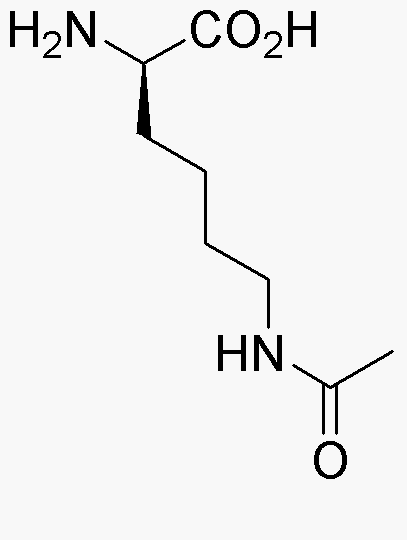Ne-Acetyl-D-lysine is widely utilized in research focused on:
- Biochemical Research: It serves as a substrate for studying lysine acetylation, a crucial post-translational modification that affects protein function and gene expression.
- Drug Development: This compound is explored in the development of new therapeutics targeting various diseases, including cancer and neurodegenerative disorders, due to its role in cellular signaling pathways.
- Nutrition Science: It is investigated for its potential benefits in dietary supplements, particularly in enhancing muscle recovery and overall metabolic health.
- Cosmetic Formulations: Ne-Acetyl-D-lysine is incorporated into skincare products for its moisturizing properties and ability to improve skin texture.
- Analytical Chemistry: It is used as a standard in mass spectrometry and other analytical techniques to quantify lysine derivatives in biological samples.
General Information
Properties
Safety and Regulations
Applications
Ne-Acetyl-D-lysine is widely utilized in research focused on:
- Biochemical Research: It serves as a substrate for studying lysine acetylation, a crucial post-translational modification that affects protein function and gene expression.
- Drug Development: This compound is explored in the development of new therapeutics targeting various diseases, including cancer and neurodegenerative disorders, due to its role in cellular signaling pathways.
- Nutrition Science: It is investigated for its potential benefits in dietary supplements, particularly in enhancing muscle recovery and overall metabolic health.
- Cosmetic Formulations: Ne-Acetyl-D-lysine is incorporated into skincare products for its moisturizing properties and ability to improve skin texture.
- Analytical Chemistry: It is used as a standard in mass spectrometry and other analytical techniques to quantify lysine derivatives in biological samples.
Documents
Safety Data Sheets (SDS)
The SDS provides comprehensive safety information on handling, storage, and disposal of the product.
Product Specification (PS)
The PS provides a comprehensive breakdown of the product’s properties, including chemical composition, physical state, purity, and storage requirements. It also details acceptable quality ranges and the product's intended applications.
Certificates of Analysis (COA)
Search for Certificates of Analysis (COA) by entering the products Lot Number. Lot and Batch Numbers can be found on a product’s label following the words ‘Lot’ or ‘Batch’.
*Catalog Number
*Lot Number
Certificates Of Origin (COO)
This COO confirms the country where the product was manufactured, and also details the materials and components used in it and whether it is derived from natural, synthetic, or other specific sources. This certificate may be required for customs, trade, and regulatory compliance.
*Catalog Number
*Lot Number
Safety Data Sheets (SDS)
The SDS provides comprehensive safety information on handling, storage, and disposal of the product.
DownloadProduct Specification (PS)
The PS provides a comprehensive breakdown of the product’s properties, including chemical composition, physical state, purity, and storage requirements. It also details acceptable quality ranges and the product's intended applications.
DownloadCertificates of Analysis (COA)
Search for Certificates of Analysis (COA) by entering the products Lot Number. Lot and Batch Numbers can be found on a product’s label following the words ‘Lot’ or ‘Batch’.
*Catalog Number
*Lot Number
Certificates Of Origin (COO)
This COO confirms the country where the product was manufactured, and also details the materials and components used in it and whether it is derived from natural, synthetic, or other specific sources. This certificate may be required for customs, trade, and regulatory compliance.


